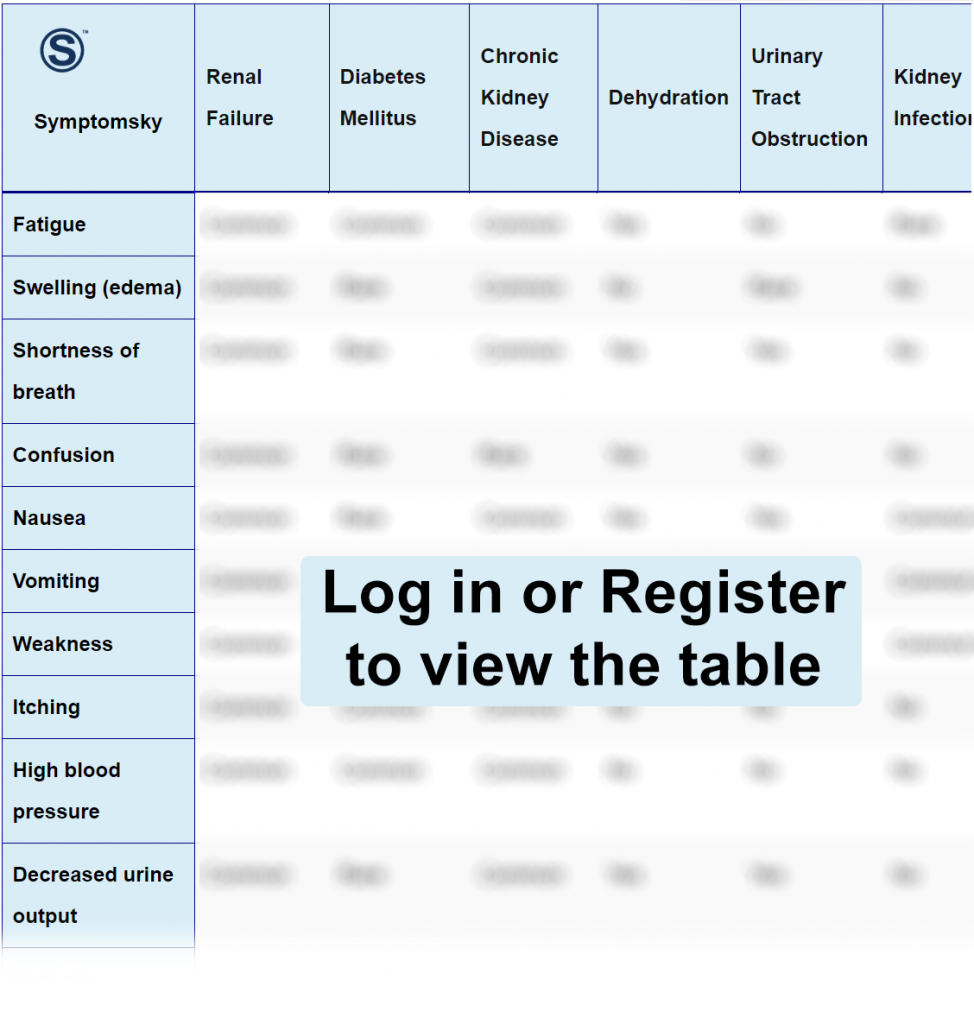Contents
- 1 Renal Failure Differential Diagnosis Table:
- 2 How to Distinguish Renal Failure from Other Conditions
- 2.1 Distinguish Diabetes Mellitus from Renal Failure – Diagnosis
- 2.2 Distinguish Chronic Kidney Disease from Renal Failure – Diagnosis
- 2.3 Distinguish Dehydration from Renal Failure – Diagnosis
- 2.4 Distinguish Urinary Tract Obstruction from Renal Failure – Diagnosis
- 2.5 Distinguish Kidney Infection from Renal Failure – Diagnosis
- 2.6 Distinguish Drug-Induced Kidney Damage from Renal Failure – Diagnosis
- 2.7 Distinguish Acute Glomerulonephritis from Renal Failure – Diagnosis
- 2.8 Distinguish Systemic Lupus Erythematosus from Renal Failure – Diagnosis
- 2.9 Distinguish Multiple Myeloma from Renal Failure – Diagnosis
- 2.10 Distinguish Hemolytic Uremic Syndrome from Renal Failure – Diagnosis
- 2.11 Distinguish Rhabdomyolysis from Renal Failure – Diagnosis
- 3 Important Red Flags with Renal Failure.
Renal Failure Differential Diagnosis Table:

Also known as kidney failure. This is basically the failure of one or both kidneys to function on their own due to a set of problems. Some of the problems that can result in kidney failure include inadequate blood flow for filtering, diabetes, high blood pressure, glomerulonephritis, polycystic kidney disease, and blockage by a kidney stone or scar.
Kidney failure can either be acute or chronic. It presents with a wide range of symptoms including confusion, internal bleeding, high blood pressure, seizures, weight loss, fatigue, itching, swelling of hands and face, nausea, and vomiting. Diagnosis is done by determining the glomerular filtration rate (GFR). Normal GFR is around 100 ml/min, so if the GFR rate is below 15 ml/min, then there is a possibility of kidney failure.
Also, the presence of creatinine in the blood shows that there is a possibility of kidney failure. This is a chemical that should be cleared by the kidney, so if it’s present in the blood, then there might be dysfunction in the kidney. Treatment of kidney failure is by replacement of the kidney or dialysis. Also, the cause should be treated or controlled.
How to Distinguish Renal Failure from Other Conditions
Distinguish Diabetes Mellitus from Renal Failure – Diagnosis
This is a disorder where the body does not produce enough insulin or respond normally, causing blood sugar levels to rise above normal levels.
- Diabetes mellitus tests include blood glucose levels, HbA1c, and oral glucose tolerance tests, while renal failure tests include serum creatinine, blood urea nitrogen, and GFR assessments.
- Diabetes mellitus involves blood sugar levels in the body, while kidney failure involves kidney function.
Distinguish Chronic Kidney Disease from Renal Failure – Diagnosis
This is a slow and progressive loss of function by the kidney. The kidney slowly loses functions like filtration of metabolic waste. It ranges from months to years.
- CKD is a slow progression of function loss while renal failure is a significant regression in kidney function.
- Diagnostic procedures involve determining GFR rate. In CKD, the GFR declines over time while in renal failure, the GFR has already declined.
Chronic kidney disease can lead to renal failure.
Distinguish Dehydration from Renal Failure – Diagnosis
This is a condition caused by the loss of too much water or rather fluids from the body without directly proportional replacement.
- Diagnostic markers for dehydration include elevated blood urea nitrogen and hematocrit and also a history of decreased fluid intake and increased fluid loss.
Distinguish Urinary Tract Obstruction from Renal Failure – Diagnosis
This is a complete or partial blockage of the urinary tract inhibiting the normal flow of urine in its normal path, including the kidneys, ureter, bladder, and urethra.
- Diagnostic markers for urinary tract obstruction include imaging tests showing obstruction and urinalysis.
- Urinary tract obstruction is a disease of the urinary tract right from the kidneys down to the urethra, while renal failure is the loss of function of the kidney alone.
Blockage can lead to kidney damage, kidney stones, and infection.
Distinguish Kidney Infection from Renal Failure – Diagnosis
Also called pyelonephritis, this is a bacterial infection (Escherichia coli) involving one or both kidneys.
- Diagnostic tests for kidney infection include urine culture, blood tests for elevated white blood cells, and imaging studies.
- Kidney infections are caused by a bacterial infection, while renal failure is caused by a wide range of intrinsic factors.
Distinguish Drug-Induced Kidney Damage from Renal Failure – Diagnosis
This is injury or damage to the kidney due to intake of drugs into the body. Common drugs include non-steroidal anti-inflammatory drugs, certain antibiotics, antivirals, and some antihypertensive medications.
- Diagnosis of drug-induced kidney damage involves a drug history of an individual and some blood tests.
- The cause of drug-induced kidney damage involves certain medication, while renal failure involves a wide range of intrinsic factors.
Distinguish Acute Glomerulonephritis from Renal Failure – Diagnosis
This refers to inflammation of the glomerulus, which is the filtration part of the kidney resulting in the presence of filtrates in already filtered blood.
- Kidney biopsy is often done for acute glomerulonephritis while it’s not always done in renal failure.
- Acute glomerulonephritis is often triggered by infections, autoimmune diseases, or drug reactions while renal failure is caused by a number of intrinsic factors e.g., hypertension or diabetes.
- Acute glomerulonephritis can be genetic.
Distinguish Systemic Lupus Erythematosus from Renal Failure – Diagnosis
This is a chronic autoimmune inflammatory condition of the connective tissue that can affect different organs of the body including kidneys, skin, and blood vessels.
- Systemic lupus erythematosus is an autoimmune condition with positive antinuclear antibodies, while renal failure does not necessarily involve autoimmune markers.
- Imaging in SLE may not be diagnostic but can be used to monitor organ involvement while imaging in renal failure may be used to determine specific structural abnormalities in the kidneys.
Distinguish Multiple Myeloma from Renal Failure – Diagnosis
This is a cancer of the plasma cells where there is an abnormal multiplication of plasma cells in the bone marrow and other organs of the body.
- Diagnosis of multiple myeloma often involves bone marrow biopsy, which shows an overgrowth of plasma cells.
Distinguish Hemolytic Uremic Syndrome from Renal Failure – Diagnosis
This is a syndrome where red blood cells and vessels are destroyed in the kidney by toxins produced by the digestive system when an infection occurs.
- Hemolytic uremic syndrome tests might show thrombocytopenia and evidence of hemolytic anemia while renal failure shows elevated creatinine levels and blood urea nitrogen levels.
Distinguish Rhabdomyolysis from Renal Failure – Diagnosis
This is a syndrome involving the breakdown of damaged skeletal muscles leading to the release of myoglobin into the bloodstream which is potentially harmful to the kidneys and can damage them.
- Rhabdomyolysis happens as a result of muscular injury while renal failure is caused by various intrinsic factors.
- Laboratory tests in rhabdomyolysis show the presence of myoglobin, creatine kinase.
Important Red Flags with Renal Failure.
There are several factors predisposing to renal failure including hypertension, diabetes, cardiovascular disease, family history, aging, and certain medications.
Some of the red flags that might indicate a possibility of renal failure might include change of urine color or blood in urine, persistent fatigue or weakness, electrolyte imbalances, unexplained weight loss, etc.
